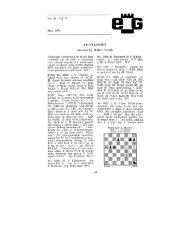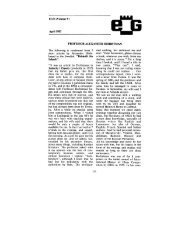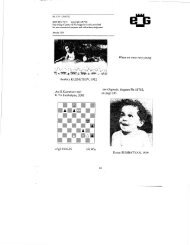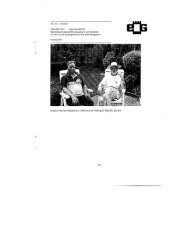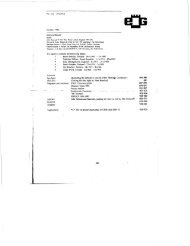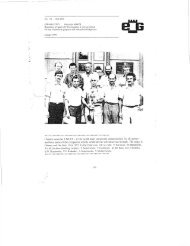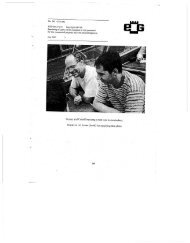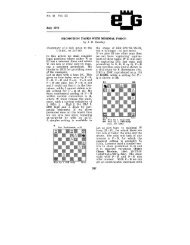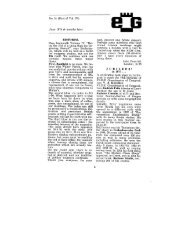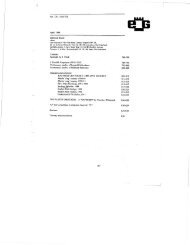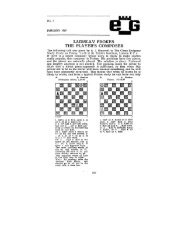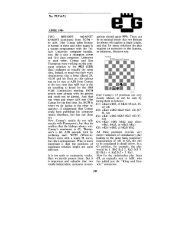You also want an ePaper? Increase the reach of your titles
YUMPU automatically turns print PDFs into web optimized ePapers that Google loves.
soundness is to dedicate it tosomebody, I sometimes feel thatselecting a piece for NC comes agood second. My original choicefor the next study broke when Iwas analysing it, and the alternativewas badly anticipated, soI thought I would save furtherthought by using one of the anticipationsinstead. It was all typedup ready for printing when WVbust it to shreds.So I have fallen back on an oldmaxim: when in doubt, quote alightweight. If you do not knowNC7.1 (F. Sackmann) then youshould. It is a twin study, W toplay and win in both parts. (Solutionat end of article.)NC7.1 F. Sackmann, 1913Win 4+2I: DiagramII: Interchange wK and wSRather longer in the unravellingthan any of the above is No. 2283(J. Fritz, draw). This is a piecewhere any gain of material willbe crucial, for R + P vsBisa winunless the weaker side can proveotherwise (so Bl to play couldclaim a win after as mild a moveas 1. .. a5). while R vs B or S ismerely a draw unless the strongerside can prove a win. Thus Wthreatens to draw by Bxa6,though he cannot play this immediatelyon account of 1. .. Rf5f2. Sf4 Rf6 3. B.. Sh5 and Bl wins.So 1. Se3 (attacking bR and sogiving no time for 1. .. a5) 1.Ra5 (stopping Bxa6, so Bl hopes- the advantage of .. Ra5 over.. Rd6 will appear after a coupleof moves) 2. Sg4f Kgl (to meetKxg3 with .. Kxfl) 3. Bxa6! andW has drawn first blood.Now the onus is on Bl to pick upmaterial, and he must somehowget bS to safety; with bR on d6 hewould have no useful move at thisstage. So 3. .. Ra3f 4. Kf4 (if Wloses touch with bS then .. Rxa6will win 4. .. Sh5f 5. Kg5 Ra5fand again where is wK to go? If6. Kg6 then 6. .. Sf4f and 7. ..Rxa6. If 6. Kh6 then again 6. ..Sf4 (threatening .. Rh5f and.. Rg5f), and if 7. Bc8 defendingwS then 7. .. Rh5f 8. Kg7 Rc5 9.Bd7 (wB must keep guard on wSto avert .. Rg5f) 9. .. Rc7 10.Sf6(e5) Sd5(d3) 11. SxS RxBfand 12. .. RxS. So it must be 6.Kh4 Sf4, and now if wB flees tosafety the near-mate by 7. ..Sg6f 8. Kg3 Ra3f forces wS tosacrifice itself (except after 7.Bb7, when 7. .. Sg6f 8. Kg3 Ra3f9. Bf3 Rb3 10. Sf2 Se5 11. Sh3fKfl 12. Sg5 Sxf3 13. Sxf3 Ke2 isgood enough). So we must try7. Kg3 and 7. •. Sg6 renews thethreat (7. .. Sh5f being of no useto Bl because of the repetitionby 8. Kh4). W's only answer tothese threats of .. Rxa6 and ..Ra3f is 8. Bd3 and after 8. .. Ra39. Sf2 Se5 it looks as if W is helpless;but the tightrope has led toa perpetual check by 10. Sh3f Khl11. Sf2f. A long and (to me) enjoyablestruggle, with every manmoving except bPa6.Solution to NC7.1: 1. g7f Kxh72. gfB. II: 1. Sf7f Rxf7 2. gf Kxh73. f8R.On 3.i.75 Richard Harman gave afully illustrated talk to The ChessEndgame Study Circle, based onthe Novotny and Plachutta studies(numbering nearly 120) in hiscollection. We hope to print thewhole talk as a Rueb Supplementin EG40 with the cooperation ofthe Rueb Foundation- AJR178



